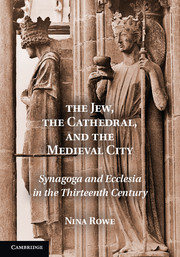Book contents
- Frontmatter
- Contents
- List of Illustrations
- Acknowledgments
- Abbreviations
- Introduction: The Jew, the Cathedral, and the Medieval City
- PART I IMAGINING JEWS AND JUDAISM IN LIFE AND ART
- PART II ART AND LIFE ON THE ECCLESIASTICAL STAGE – THREE CASE STUDIES
- Introduction to Part II: Nature, Antiquity, and Sculpture in the Early Thirteenth Century
- 3 Reims: “Our Jews” and the Royal Sphere
- 4 Bamberg: The Empire, the Jews, and Earthly Order
- 5 Strasbourg: Clerics, Burghers, and Jews in the Medieval City
- Epilogue: The Afterlife of an Image
- Notes
- Glossary
- Bibliography
- Index
Introduction to Part II: Nature, Antiquity, and Sculpture in the Early Thirteenth Century
Published online by Cambridge University Press: 05 January 2012
- Frontmatter
- Contents
- List of Illustrations
- Acknowledgments
- Abbreviations
- Introduction: The Jew, the Cathedral, and the Medieval City
- PART I IMAGINING JEWS AND JUDAISM IN LIFE AND ART
- PART II ART AND LIFE ON THE ECCLESIASTICAL STAGE – THREE CASE STUDIES
- Introduction to Part II: Nature, Antiquity, and Sculpture in the Early Thirteenth Century
- 3 Reims: “Our Jews” and the Royal Sphere
- 4 Bamberg: The Empire, the Jews, and Earthly Order
- 5 Strasbourg: Clerics, Burghers, and Jews in the Medieval City
- Epilogue: The Afterlife of an Image
- Notes
- Glossary
- Bibliography
- Index
Summary
The chapters in the first part of this study tracked the shifting notion of the Jew in Christian theology, legal codes, and social life from late antiquity to the thirteenth century and examined the development of the Ecclesia-Synagoga motif in texts and images. By the mid-twelfth century, artists had established conventions for representing the dueling personifications of Church and Synagogue. The former could readily be recognized through her attributes of crown, chalice, and triumphal standard. The latter was marked by her blindfold or veil; often she bore the instruments of the Passion and was seen either rejecting or being rejected by Christ. Once this iconography was fixed, artists had at their disposal a visual means to convey a range of Christian notions about history and scripture. The triumphant Ecclesia and the defunct Synagoga depicted at the foot of the cross demonstrated the notion that, with Christ's sacrifice, the era of the law ceded to the age of grace. The antipodal figures likewise could proclaim the obsolescence of Judaism in a Christian world. Or alternatively, the paired queens could indicate a harmony between Old and New Testament texts, Synagoga foreshadowing the revelation embodied in Ecclesia.
But it was only in the thirteenth century, when ecclesiastical and lay leaders were increasingly uneasy about Jewish denunciations of Christian belief, Jewish profiteering at the expense of Christians, the liberty with which Jews circulated unrecognized throughout Christian cities, and the other developments reviewed in the first chapter of this book, that the Ecclesia-Synagoga motif was adopted in monumental, lifelike form as a constitutive element within the decorative programs of some of the most ambitious urban building projects of the day.
- Type
- Chapter
- Information
- The Jew, the Cathedral and the Medieval CitySynagoga and Ecclesia in the Thirteenth Century, pp. 81 - 85Publisher: Cambridge University PressPrint publication year: 2011



